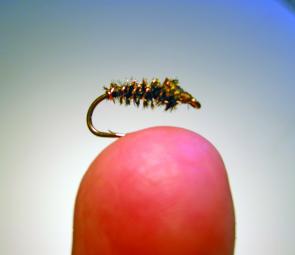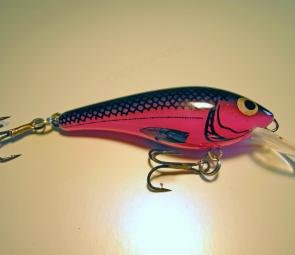August is known as the windy month throughout the Northern Tablelands and few consider it a month to hit the water in search of a fish.
The bass are long gone, the cod have shut down and the impoundments are generally bumpy and cold. So what is a fisho to do?
Let me introduce you to the midge. Midges are the savour for late Winter trout fishing.
Sure, the streams are out of season but across the north, and indeed throughout the State, August is a prime time to target midge-feeding trout.
Midges are small, non-biting insects very similar to mosquitoes in appearance. Anyone who has spent some time around still water will have seen the clouds of tiny black insects, usually prior to dusk.
They spend much of their life as larvae in silt or muddy bottoms and emerge as pupae to swim up to the surface and hatch.
During the colder months many of a still-water trout’s prey items, such as yabbies and mayfly nymphs, are relatively dormant yet midges revel in the cold. The trout key onto the prolific hatches and offer exciting angling opportunities.
The northern region is blessed with a number of excellent, although small, trout lakes. The public waters of Sheba Dams, near Tamworth, Dumaresq Dam, near Armidale, and the Beardy Waters outside Glen Innes offer readily accessible Winter trout opportunities.
And if you are willing to part with a few dollars you’ll find premier sole angling rights at private impoundments such as Uncle Billy’s or Dunmore Trout Waters near Guyra and at Lothorian, near Niangala. For further information contact the relevant tourism offices.
Prime locations to seek out midge-feeding trout at any of these venues are the sections of shoreline where shallows merge with the deeper drop-offs.
Channels of deeper water that cut into the shallows are prime locations. These ‘gutters’ will be used by cruising fish to patrol the shallows without exposing themselves. This is particularly true on bright, sunny days.
Silt or mud bottoms hold higher concentrations of midges. Avoid stony or pebbly shorelines; leave them for Summer when the yabby and mayfly are about.
The hottest action will often occur in the last half-hour before dark. Still evenings provide the most visual action with fish characteristically ‘porpoising’ or exposing their backs as they feed in the upper water column.
One of the most frustrating aspects of midge-feeding fish is that the plentiful action focuses almost exclusively on the midge and the midge only.
You can spend a hell of a lot of time throwing every lure and fly in your box at active fish for little or no response.
Anglers have two choices, depending upon their preferred method.
Fly-flickers need to be patient. Find a location and focus exclusively upon the active fish within casting distance.
Often, lake fish will begin rise well out in the impoundment, often beyond even the longest cast.
The key is to wait for the fish to move into the shallows. This will happen as the light fades and you must be prepared for a period of brief but intense opportunity.
I generally fish a pair of flies, the patterns dictated by the conditions.
On a still evening with plenty of active fish, I prefer to couple a dry fly such as a Red Tag with a midge pupa. If the wind is up, switch to a pair of pupa imitations.
Cast to the area of most activity and let the flies sit. Ignore the temptation to retrieve.
Natural pupae rise vertically through the water column with little horizontal movement and your imitations should remain static.
Keep a tight line to the flies as takes are very subtle and often missed by most anglers. Watch for movement of the leader or boils near your flies.
Ignore the temptation to tie on a large fly in the belief that the fish will see it easier and hit it. Midge feeders are eating midges and if you persevere your catch rate will climb.
The simplest fly pattern is a size 14 hook with a body of peacock herl and a head made from several turns of white dubbing.
Lure-tossers are in a bind because although there are some skilful lure makers out there, no one has yet developed a lure imitation the size of a pea. Casting it is another question!
Generally, midge feeders are operating in the top of the water column and unfortunately most trout lures don’t retrieve in that area. Often your lure is working too deep and goes unnoticed.
The option is to use either a very shallow-running lure or a combination of float and fly.
Shallow-running lures are available but your best bet is a small minnow pattern with the bib ground away. Tin snips and a small file will do the business and you are left with a lure that will still cast but will not dive on the retrieve.
Retrieval rates should be ultra-slow with frequent pauses. The fish at this time are highly mobile so give them time to find your lure.
Generally I prefer lure bodies in bright colours and pink continues to be the most reliable.
The float-and-fly option is a great standby. Bubble floats, particularly the clear models that you can weight by adding water through the slits, get around the problem of casting weight.
A midge pupa pattern about a metre beyond the float will give the best chance for success. If a float isn’t available, consider tying a fly off the trailing hook of your lure and retrieving ultra-slowly.
Midge-feeding trout and New England impoundments offer anglers some respite from the fishing doldrums of the coming month or two.
Few locals exploit this period of trout action and although the fish can be fussy, the rewards for those who persevere are some great angling fun.
So rug up and go hammer a midge feeder!!
Reads: 4055
Midge pupa patterns may be small but trout love them. Tie one on!

Small minnow-style lures in bright colours. Modify or remove the bib for an ultra shallow runner.




